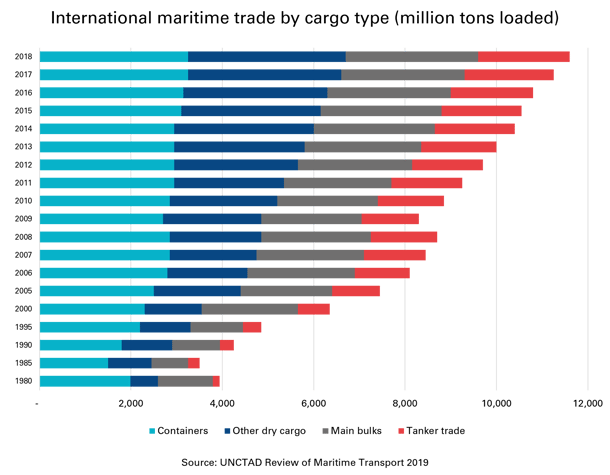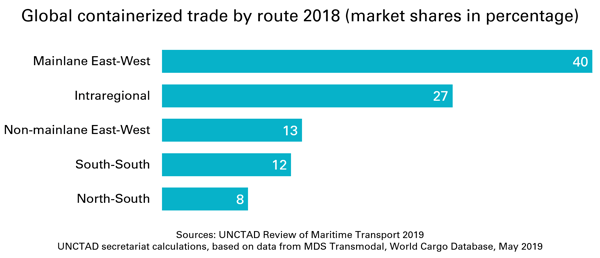Import and export refers to a set of goods and services that a country buys and sells to other countries in the world. The volume of goods and services marketed between different countries, together with Foreign Direct Investments (FDIs), determines the volume of international trade. In this article, we will provide an overview of international trade, trends, freight flows and shipping routes.
To sum up, we try to provide answers to the following questions:
-
What is international trade and how has it evolved in terms of flows and volumes?
-
What are the main modes of transport and the corridors used?
International trade
The importance of international trade has increased significantly in the past centuries, thanks to some factors including industrialization, advanced technology in the transport sector, globalization and the rise of multinationals, which have brought far-reaching changes not only at an economical, but also a social, political and cultural level.
In 2009-2018, the overall trade in goods and services in the world grew by 57%, with a decrease between 2015-2016, reaching a value of over 25 thousand billion dollars in 2018 (data processing from ISTAT – Italian Institute of Statistics).
International trade is based on a large set of commercial agreements which can indicate customs tariffs, trade taxes and guarantees on investments between two or more states.
Over the years, several free trade areas have formed, with a goal to facilitate international trade, especially between countries in the same region.
Furthermore, since 1936, the ICC International Chamber of Commerce have created and periodically updated some internationally recognized contractual clauses, named Incoterms.
The importance of maritime transport in international trade
According to data from the UNCTAD Review of Maritime Transport 2019, maritime transport remains the backbone of globalized trade and the manufacturing supply chains. Indeed, over 4/5 of the world trade in goods by volume are transported by sea. In 2018, the volume of international maritime trade increased by 2.7% and reached an all-time high of 11 billion tons.
What kind of ships are used for maritime trades?
Since the 1980s, the composition of the maritime trade has changed significantly. Oil tanker trade has progressively decreased, reflecting the limited oil consumption following the oil shocks of the 1970s. Over the same period, trade in the main solid bulk items, including iron ore, wheat and coal, increased by more than 50%. Containerized cargo expanded at the fastest pace, with volumes recording an average annual increase of 8% between 1980 and 2018.
In 2018, the volumes of traffic of container ships increased by 2.6%, reaching 152 million TEU.
TEU (which stands for Twenty-foot Equivalent Unit) is the standard measurement of volume in the intermodal transport of ISO containers (which precisely measure 20 ft long x 8 ft wide x 8.5 ft high) and corresponds to about 38 cubic meters. This measure is used to determine the capacity of a ship in terms of the number of containers, or the number of containers handled in a port over a certain period of time, and can be the unit of measure by which the cost of a transport is determined.
What are the main commercial routes of container ships?
Much of the globalized containerized trade (40%) continues to be transported through the main east-west trade arteries, mainly the Asia-Europe, the Trans-Pacific and the Transatlantic routes.
Trans-Pacific trade remained the busiest trade route, with 28.2 million TEU, followed by the Asia-Europe route (24.4 million TEU) and the transatlantic route (8 million TEU).
Interestingly, secondary routes, which involve trade in developing countries, are increasingly important. Among these routes, intra-regional flows, dominated by intra-Asian movements, hold the largest market share, accounting for 27% of global container traffic.
Finally, we notice that other secondary trade routes (for example, East-South-West Asia) and the South-South and North-South trade routes, account for 13%, 12% and 8% of the total container traffic, respectively.






